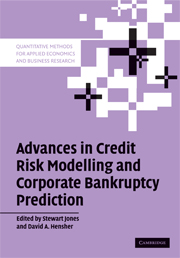Book contents
- Frontmatter
- Contents
- List of figures
- List of tables
- List of contributors
- Introduction
- 1 A statistical model for credit scoring
- 2 Mixed logit and error component models of corporate insolvency and bankruptcy risk
- 3 An evaluation of open- and closed-form distress prediction models: The nested logit and latent class models
- 4 Survival analysis and omitted dividends
- 5 Non-parametric methods for credit risk analysis: Neural networks and recursive partitioning techniques
- 6 Bankruptcy prediction and structural credit risk models
- 7 Default recovery rates and LGD in credit risk modelling and practice: An updated review of the literature and empirical evidence
- 8 Credit derivatives: Current practices and controversies
- 9 Local government distress in Australia: A latent class regression analysis
- 10 A belief-function perspective to credit risk assessments
- Index
- References
2 - Mixed logit and error component models of corporate insolvency and bankruptcy risk
Published online by Cambridge University Press: 11 June 2010
- Frontmatter
- Contents
- List of figures
- List of tables
- List of contributors
- Introduction
- 1 A statistical model for credit scoring
- 2 Mixed logit and error component models of corporate insolvency and bankruptcy risk
- 3 An evaluation of open- and closed-form distress prediction models: The nested logit and latent class models
- 4 Survival analysis and omitted dividends
- 5 Non-parametric methods for credit risk analysis: Neural networks and recursive partitioning techniques
- 6 Bankruptcy prediction and structural credit risk models
- 7 Default recovery rates and LGD in credit risk modelling and practice: An updated review of the literature and empirical evidence
- 8 Credit derivatives: Current practices and controversies
- 9 Local government distress in Australia: A latent class regression analysis
- 10 A belief-function perspective to credit risk assessments
- Index
- References
Summary
Introduction
Mixed logit is the latest among a new breed of econometric models being developed out of discrete choice theory (Train 2003). Discrete choice theory is concerned with understanding the discrete behavioural responses of individuals to the actions of business, markets and government when faced with two or more possible outcomes (or choices) (Louviere et al. 2000). Its theoretical underpinnings are derived from microeconomic theory of consumer behavior, such as the formal definition of agent preferences as inputs into a choice or outcome setting as determined by the utility maximization of agents. Given that the analyst has incomplete knowledge on the information inputs of the agents being studied, the analyst can only explain a choice outcome up to a probability of it occurring. This is the basis for the theory of random utility (see Louviere et al. 2000 for a review of the literature). While random utility theory has developed from economic theories of consumer behaviour it can be applied to any unit of analysis (e.g., firm failures) where the dependent variable is discrete.
The concept of behavioural heterogeneity (individual variations in tastes and preferences), and how this impinges on the validity of various theoretical and empirical models has been the subject of much recent attention in this literature. However, econometric techniques to model heterogeneity have taken time to develop, despite a long-standing recognition that failure to do so can result in inferior model specification, spurious test results and invalid conclusions (Louviere et al. 2000; Train 2003).
- Type
- Chapter
- Information
- Publisher: Cambridge University PressPrint publication year: 2008
References
- 4
- Cited by



